Original source: http://www.bbc.co.uk/sport/rugby-union/57595699
Thursday, June 24, 2021
British and Irish Lions v Japan: Zander Fagerson replaced by Tadhg Furlong
Wednesday, June 23, 2021
White to miss France series after injuring knee at training
Wallabies halfback Nic White is out of next month’s Test series against France, while fellow veterans Matt Toomua and James O’Connor are also battling injuries, potentially robbing the side of almost 150 Test caps.
White has returned home to Canberra after suffering a MCL injury at training during their Gold Coast camp, and Toomua is already there with his injury being checked by Rugby Australia’s chief medical officer, Warren McDonald.
Toomua is expected to rejoin the squad on Sunday with the Wallabies hopeful the playmaker will be available for the first Test on July 7.
O’Connor, who has carried the injury from Super Rugby Trans-Tasman, is being managed through training but the five-eighth is expected to play.
With White out, Queensland’s Tate McDermott is now set for his first Test start after two matches off the bench, while Brumbies No.9 Ryan Lonergan is likely to make his debut.
Waratahs halfback Jake Gordon is in camp but is also recovering from a MCL injury and remains an outside chance of being available.
White doesn’t require surgery and medical staff are hopeful he will be in the frame for the Bledisloe Cup with the first match on August 7 in Auckland.
It comes as Rugby Australia push ahead with plans to play the opening match of the three Test series against France at the SCG despite the COVID-19 outbreak in Sydney.
The 42-man French squad arrived in Sydney on Tuesday night and underwent COVID-19 tests on Wednesday.
Les Bleus will be quarantined in their hotel for the next fortnight though they will be allowed out to train ahead of the July 7 Test at the SCG.
The teams are playing a condensed series with three Tests in 11 days, the second at Melbourne’s AAMI Park on July 13 followed by the third at Suncorp Stadium in Brisbane on July 17.
The second Test looked to be in most doubt, with Melbourne in lockdown for two weeks after a rise COVID-19 cases, but that has eased with crowds welcomed back to sporting events this weekend.
There were questions about whether that game would be shifted to Canberra, which could now be an option for the Sydney match should the pandemic continue to worsen on the eastern seabelt.
Queensland and Victoria have closed their borders to NSW residents from hotspot areas in the eastern suburbs and central Sydney.
RA chief executive Andy Marinos said they remained hopeful the matches would be played as scheduled.
“Appreciating that we continue to operate in a dynamic environment with COVID-19 impacts, we are moving ahead with our plans to host these matches as planned, subject to any further
advice from our state government partners,” Marinos said in a statement.
“We are now just two weeks away from the start of the series which kicks off with the Wallabies’ first match at the historic Sydney Cricket Ground in 35 years.
“I want to thank (president) Bernard Laporte, (coach) Fabian Gautier and the FFR (French Rugby Federation) for their partnership in ensuring this series could go ahead.
“It has been a mammoth effort by all involved.”
Original source: https://www.theroar.com.au/2021/06/24/white-to-miss-france-series-after-injuring-knee-at-training/
https://therugbystore.com.au/white-to-miss-france-series-after-injuring-knee-at-training/
British and Irish Lions v Japan: Justin Tipuric replaces Hamish Watson in line-up
Original source: http://www.bbc.co.uk/sport/rugby-union/57582450
Tuesday, June 22, 2021
South Africa and Argentina begin their game review
Any enigma about the physical preparation and the evolution of the Springboks’ game will be revealed when they face the British and Irish Lions.
Given the Springboks have not participated in any competitions since the end of 2019, and with most of their key players playing abroad, it is difficult to analyze the medium-term prospects that would deposit them at the gates of the Rugby Championship 2021.
In principle, one of the keys to dismantling the South African defensive game lies in avoiding or controlling the rapid pressure they exert through no’s. 6-8 and no. 9: fast and direct through the shortest channel until crashing into the opponent’s attack.
Physicality on the occasion of contact is the central axis of the South African strategy, with almost 98 per cent effectiveness in ruck and 85 per cent in positive tackles.
At the last Rugby World Cup in 2019, the Springboks left their qualifying group behind by playing good rugby but mostly focused on the potential to score points. But as they progressed towards the final stages of the tournament, their try power diminished until they faced England with an accumulated net difference of +13 tries in their favour.
So far a quick overview of the current world champion. But one thing will be certain: nothing that happens in the series with the Lions will determine the aspirations to impose their leadership and physical might in the rugby ecosystem of the southern hemisphere.
More AFL
- Four incredible years of sport: My farewell to The Roar
- AFL full of hypocrisy and mixed messages on concussion
- The Roar bids farewell to Managing Editor, Daniel Jeffrey
- Essendon Round 14 review
- AFL combined team (Part 2)
A similar situation occurs with Argentina, who dispersed their men in European professional rugby and, to a lesser extent, Australia. After a disappointing performance at the World Cup, the Pumas managed to shore up their game at the Tri-Nations in 2020, based on defensive strength (86.2 per cent on positive tackles) and relative control of the breakdown.
Finally their second position in the championship was ensured by the effectiveness of kicking the sticks but also showing notable advances in scrummaging (after hitting rock bottom in 2017) and lineout, where they presented, among others, the winning card of Guido Petti as the best jumper of Super Rugby in the last year of Jaguares.
Regarding the scrummaging technique called ´La Bajadita´, promoted by Argentina at the Tri-Nations, you can consult its current implications in contemporary rugby in this article by Nick Bishop.
What should we expect from Los Pumas in the next matches? Matches against Wales in July will give us approximate form of the Argentine team. But we can point out something that differentiates the Argentine team for some years and that could be healthy.
First, we see a strong correlation between granted turnovers and the dramatic change in status, where the ‘disorganised Latino’ temperament shows its achievements by incredibly disorganising the world’s tightest defences.
The other point that perhaps the Argentine team should enhance, in addition to other variations to the monolithic defence already presented, is obtaining more fluid access routes to the opponent’s territory to transform possession and territory into tries.
The kicking game could be an avenue. The conservative conduction of the phase game could be another. In the 2020 Tri-Nations, the opponent’s 22-metre penetrating effectiveness was 9.6 per cent compared to 10.5 per cent for Australia and 37.2 per cent for New Zealand.
So far, that’s my vision of things. Once the luminaire originating from the recent Super Rugby Trans-Tasman is extinguished, we will see what Australia and New Zealand haver in store for us.
Original source: https://www.theroar.com.au/2021/06/23/south-africa-and-argentina-begin-their-game-review/
https://therugbystore.com.au/south-africa-and-argentina-begin-their-game-review/
British and Irish Lions: Eight debutants to face Japan
Original source: http://www.bbc.co.uk/sport/rugby-union/57567198
https://therugbystore.com.au/british-and-irish-lions-eight-debutants-to-face-japan/
Monday, June 21, 2021
Why are we not excited about the naming of the All Blacks squad?
What used to be one of the most anticipated moments of my life has now evolved into a modicum of enthusiasm.
It may be because I am now a New Zealander living in Australia where the media attention for rugby is so much less than NZ, but I feel that the naming of the All Blacks squad is less of a big deal than previously.
And no, I have not become an AFL fan, I have tried hard to like it and know enough to fake a conversation, but still do not get the enthusiasm for it.
I remember the heated debates with mates and fellow workers as to who would make the team and there was always a “Pick the All Blacks” competition running somewhere.
If the team named by the public could ever take the field who knows what the result would be. I would say that several Kiwis could pick a better team than what Ian Foster and co have just done.
I believe I never ever managed to select the whole squad as named by selectors but did come close. There was always a bolter in there.
Bolters usually do not work, do they? The “experiments” usually did not develop as planned either.
So, to the All Blacks squad to start 2021, with Tests against Fiji and Tonga.
Forwards
Hookers
Asafo Aumua (24, Hurricanes / Wellington, 1)
Dane Coles (34, Hurricanes / Wellington, 74)
Codie Taylor (30, Crusaders / Canterbury, 56)
Props
George Bower (29, Crusaders / Otago, uncapped)
Ethan de Groot (22, Highlanders / Southland, new cap)
Nepo Laulala (29, Blues / Counties Manukau, 29)
Tyrel Lomax (25, Hurricanes / Tasman, 6)
Angus Ta’avao (31, Chiefs / Auckland, 14)
Karl Tu’inukuafe (28, Blues / North Harbour, 17)
Locks
Scott Barrett (27, Crusaders / Taranaki, 36)
Brodie Retallick (30, Chiefs / Hawke’s Bay, 81)
Patrick Tuipulotu (28, Blues / Auckland, 35)
Tupou Vaa’i (21, Chiefs / Taranaki, 4)
Samuel Whitelock (32, Crusaders / Canterbury, 122) – captain
Loose forwards
Ethan Blackadder (26, Crusaders / Tasman, new cap)
Shannon Frizell (27, Highlanders / Tasman, 13)
Akira Ioane (26, Blues / Auckland, 2)
Luke Jacobson (24, Chiefs / Waikato, 2)
Dalton Papalii (23, Blues / Counties Manukau, 4)
Ardie Savea (27, Hurricanes / Wellington, 49)
Hoskins Sotutu (22, Blues / Counties Manukau, 5)
Backs
Halfbacks
Finlay Christie (25, Blues / Tasman, new cap)
Aaron Smith (32, Highlanders / Manawatu, 97)
Brad Weber (30, Chiefs / Hawke’s Bay, 7)
First five–eighths
Beauden Barrett (30, Blues / Taranaki, 88)
Richie Mo’unga (27, Crusaders / Canterbury, 22)
Midfielders
Braydon Ennor (23, Crusaders / Canterbury, 1)
David Havili (26, Crusaders / Tasman, 3)
Rieko Ioane (24, Blues / Auckland, 33)
Anton Lienert-Brown (26, Chiefs / Waikato, 49)
Quinn Tupaea (22, Chiefs / Waikato, new cap)
Outside backs
Jordie Barrett (24, Hurricanes / Taranaki, 23)
George Bridge (26, Crusaders / Canterbury, 10)
Will Jordan (22, Crusaders / Tasman, 2)
Damian McKenzie (26, Chiefs / Waikato, 27)
Sevu Reece (23, Crusaders / Tasman, 8)
Living in Australia makes it difficult to get to know all the players and be familiar with their overall form. But I will do the best I can.
Overall, the response to the hookers named seems to be quite positive. Coles and Taylor are the veterans with the young blood snapping at their heels.
The murky depths of the prop world are left to the scrummaging experts, and you must take their word for it. I always liked the running prop myself. Ethan de Groot at 22 is extremely young to be named so we hope he lives up to the promise.
Five locks were named with one of them, Samuel Whitelock named as skipper, replacing Sam Kane. Scott Barrett joins his two brothers in the squad. I do not know a lot about Tupou Vaa’I, the young Chiefs lock, but maybe a reader is more familiar with him?
You know you are getting old when sons of players you followed years ago, are named in current teams! Ethan Blackadder, son of Todd has been named as a loose forward. As an aside, Michael Lynagh’s son Louis is now also becoming a prominent player.
The rest of the loose forwards are named on form with Shannon Frizell, brother of Tyson, a St George player in NRL, reclaiming his spot.
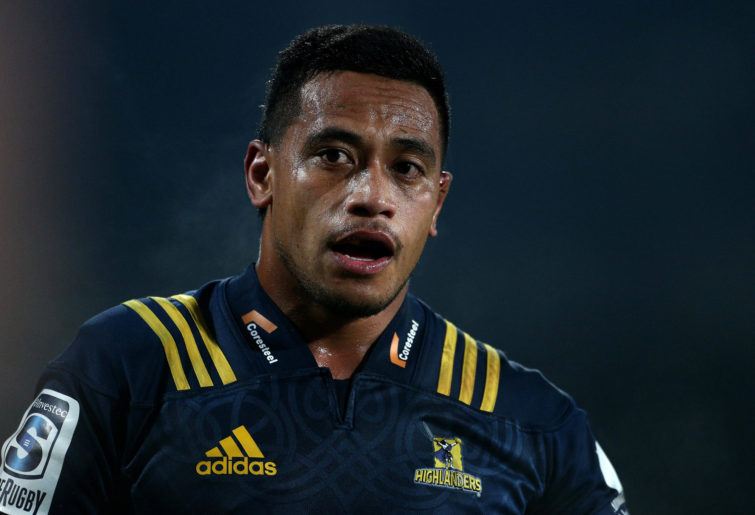
(Dianne Manson/Getty Images)
T.J Perenara was ineligible for this squad and his place goes to Finlay Christie, the Scottish born Blues halfback.
Richie Mo’unga and Beauden Barrett are the first five-eighths selected with some questioning why a third five-eighth was not picked. Maybe they have Damian McKenzie in mind as well.
I do have question marks over Barrett and whether his glory days are behind him. I am sure that is what they said about Dan Carter too. Like a Benji Marshall or Shaun Johnston in the NRL, they just become different players.
The midfield backs are solid selections and hopefully a partnership is built up over this season in preparation for the next World Cup. The All Blacks have not had a settled midfield since Conrad Smith and Ma’a Nonu.
The durable partnership of Frank Bunce and Walter Little is a distant memory. Please do not ask me about Quinn Tupaea, the 22-year-old Chiefs player selected as I have no idea!
More Rugby
- Why are we not excited about the naming of the All Blacks squad?
- Get your questions in for Issue 18 of Coach's Corner
- The Wrap: A celebration of Blue, 50 and 18 years on
- Consolidate to survive: Five teams must become four if Super Rugby is to survive
- Brumbies: Never look a gift horse in the mouth!
The outside backs named are Jordie Barrett, George Bridge, Will Jordan, Damian McKenzie and Sevu Reece. Barrett is a good player, but I am yet to be convinced by him for some reason.
Maybe it is the haircut or the way he runs, I do not know! George Bridge I worry about, he is getting to that age when wingers start to lose their place, and I thought he was shown up in the last World Cup. Maybe there is a better option?
Will Jordan has impressed me with the limited viewing I have seen of him, and he is at that age where he has it all in front of him. McKenzie is a fantastic player yet to cement his spot in the All Blacks. Is it full back or first five?
Time will tell. Sevu Reece is another yet to convince me of a long-term career in the All Blacks. We have been spoilt with great wingers over the years with Lomu, Bryan Williams, Kirwan, and the two Wilson’s as examples. So, a player like Reece has a lot to live up to.
Overall, a conservative team named, from a conservative coach. Is this the beginnings of a team that will take us through to the next World Cup?
The loose forwards, halfback, first-five, midfield, wing, and full back are concerns. I believe I just about included the whole team there! Time will tell.
Original source: https://www.theroar.com.au/2021/06/22/why-are-we-not-excited-about-the-naming-of-the-all-blacks-squad/
https://therugbystore.com.au/why-are-we-not-excited-about-the-naming-of-the-all-blacks-squad/
Tom Youngs: Leicester hooker accepts two-week ban for disrespecting match official
Original source: http://www.bbc.co.uk/sport/rugby-union/57554547
Sunday, June 20, 2021
Manu Tuilagi: England coach Eddie Jones adds Sale centre to squad for July Tests
Original source: http://www.bbc.co.uk/sport/rugby-union/57547865
Get your questions in for Issue 18 of Coach’s Corner
The inaugural Super Rugby Trans-Tasman season is done and dusted, so we’re counting down the days until the international fixtures kick off in this week’s edition of Coach’s Corner.
Every Friday, our rugby analyst here on The Roar, Nick Bishop, answers your questions about the goings-on across the rugby world
Miss the latest issue of Coach’s Corner? Catch up right here!
With the first Test against France now just a fortnight away, all eyes turn to the Wallabies as they prepare to try and stun France at the SCG. The European powerhouse won’t be at full strength, thanks to results in the Top 14; Toulouse’s semi-final win meaning stars Antoine Dupont and Romain Ntamack, among others, won’t make it through Australia’s overseas quarantine in time for the first Test at least.
Do the Aussies have a chance of getting the jump on Les Bleus? Or will their All Blacks-esque squad depth hold the visitors in good stead?
In other Wallabies news, captain Michael Hooper has issued a warning that overseas sabbaticals are the only way to move Australian rugby forward, given the continued struggle of the sport on home soil.
Is it time for Rugby Australia to move on from the old ways? Or is there a middle-ground solution to help get the code out of its funk?
Across the ditch, the other Blues broke an 18-year title drought to claim Super Rugby Trans-Tasman glory, with a hard-fought final win over the gutsy Highlanders. The 23-15 win, thanks to a late Ben Gibson try, breaks the Crusaders’ stranglehold on southern hemisphere rugby, and sparked scenes of joy at Eden Park.
Further north, the Harlequins pulled off one of the sport’s greatest comebacks in the English Premiership semi-final. They gave Bristol Bears a 28-0 half time lead before a blistering second stanza saw them win 43-36, seeing them through to the final against Exeter. And how could we forget Louis Lynagh, son of Wallabies great and captain Michael, flattening none other than the Fijian Flyer himself, Semi Radradra?
Got a question for Nick? Be sure to leave it in the comments section below, and come back later in the week to see his answers!
Original source: https://www.theroar.com.au/2021/06/21/get-your-questions-in-for-issue-18-of-coachs-corner/
https://therugbystore.com.au/get-your-questions-in-for-issue-18-of-coachs-corner/
Saturday, June 19, 2021
The 1995 decisions that took southern hemisphere rugby down the wrong path
This article is in response to the recent article by Brett McKay highlighting calls by various coaches and personalities to bring back the NRC.
Apart from the obvious fact Rugby Australia doesn’t have the money to reprise the NRC – or ARC, for that matter – I’ve always disputed its legitimacy on the grounds it duplicated unnecessary resources.
Southern hemisphere rugby, including Australian rugby, took a wrong turn back in 1995. Everything they’ve done since has created extra expenses, required extra funds, which in turn meant seeking out extra, impractical revenue streams that were unnecessary.
How for example, is it a victory for South African Super Rugby teams to move offshore to Europe, to be soon followed presumedly by the Springboks?
Back in 1995 the southern hemisphere had a structural set-up that was close to perfect. What it required was fleshing out and building upon the solid footings and foundations already long established, not displacing them, as occurred when the game went professional in 1996.
New Zealand had its NPC divided into several divisions. South Africa likewise had its Currie Cup divided into several divisions. Even the staunchly amateur Argentina had a similar set-up, with its 16 provinces divided into two divisions.
Australia of course was the weak link. It had only two provinces of note: New South Wales Queensland. But there was room for future growth with long-established minor provinces such as ACT, Victoria, Western Australia, South Australia, NSW Country and Queensland Country.
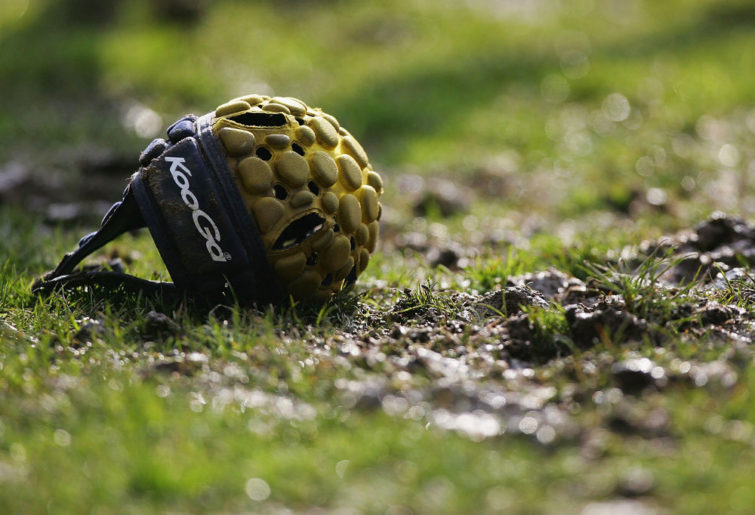
Down the track NSW Country could have been embedded in Newcastle and created the new province of Eastern Australia. Similarly, Queensland Country could have been embedded in Townsville to create North Queensland. In the embryonic years of the game, before the union-league split of 1907, these two regions produced plenty of Wallabies.
When professionalism came, each of the southern hemisphere nations – New Zealand, South Africa, Argentina and Australia – should have been encouraged to form an eight-team national competition.
The three first-named nations could have done this relatively quickly, with Australia perhaps starting with six teams and building towards eight teams. The Super 10 of 1993-95 was effectively a Champions Cup and should have remained so. In 1996 it could have been expanded to 12 teams, three per nation, and contested after the respective national tournaments.
The season would have unfolded as follows: an eight-team competition of home-and-away games totalling 14 matches plus a final four. This would have meant a season of 14 to 16 matches per team.
The top three teams from each country would then contest the Super 12 – four pools of three teams. This would be quickly over with each team playing two to four matches. Meanwhile, the remaining teams in the various national competitions could conduct a knockout style tournament involving no more than four matches for the finalists.
Consequently each team in each country would play between 16 and 20 matches, which is plenty for a first-class-style season. Add a preseason of three to four matches and combine that with ten to 12 Tests per nation, and the season is pretty much full.
Sports opinion delivered daily
Finally, the Rugby Championship was a great addition to the annual season.
I would have loved, for example, watching the Wallabies, All Blacks, Springboks and Pumas circa 1985 being guided around the park by their champion number-10s in Mark Ella (then Mike Lynagh), Wayne Smith (then Grant Fox), Naas Botha and Hugo Porta.
The various national competitions would have worked like the Sheffield Shield in its heyday, with established stars, young up-and-comers and still-performing veterans all in the same team, the experienced mentoring the newcomers and testing the same in the opposition.
In Australia the depth would have been initially weak, but as the national competition gained traction, hopefully this problem would have been rectified.
But sadly none of this happened. It is a little-known fact that in 1996 the working title for Super 12 was the IPC – International Provincial Championship. In other words, it was supposed to work exactly the same as the Super 10 of 1993-95.
The Kiwis were first to blink. Instead of staring down the minor provinces and stating that the top eight provinces should come from the eight biggest geographical regions, they rolled over and created five artificial franchises.
The Saffies held the line for several seasons, but by 1999 they also buckled and created four, then five and later six artificial franchises. However, unlike New Zealand, the South African franchises in most cases didn’t pretend to be very different from their major provinces.
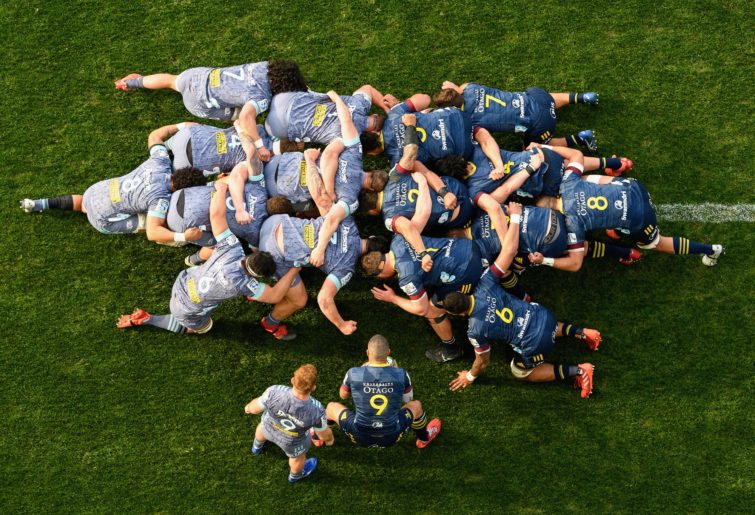
(Photo by Kai Schwoerer/Getty Images)
Australia of course didn’t have to worry about these trivialities. It quite proudly created – or rebranded – the ACT, giving it three provinces. But eventually it had another problem. While New Zealand and South Africa had their national tournaments to fall back on as a mid-tier competition, Australia had no such thing.
While once upon a time the Sydney Shute Shield and Brisbane Hospital Cup might have done the job of producing future Wallabies, the caravan had moved on since leading players were almost never seen in district club rugby. So those players plying their trade in these competitions were not getting the development they needed.
Consequently, the then Rugby AU introduced the ARC in 2007 and the NRC in 2014-19. Both competitionss have struggled with poorly conceptualised teams, financial blowouts and a lack of support. Duplication of resources hasn’t helped the financial bottom line.
Over at SANZAAR, things just went from crazy to crazier. While introducing an Argentine team was absolutely necessary to complement the Pumas, the introduction of a Japanese team was pie-in-the-sky stuff. Meanwhile, the Saffies failed to stare down their government and advise them clearly there was no place for a sixth franchise.
More Rugby
- The 1995 decisions that took southern hemisphere rugby down the wrong path
- Blues claim Super Rugby Trans-Tasman glory in thrilling final
- Super Rugby Trans-Tasman final: Blues vs Highlanders live scores
- Who gets to wear gold? Why Dave Rennie is right and Marika Koroibete must choose
- Four more years of Super Rugby? I bloody well hope not!
Super Rugby never really gained traction once the initial novelty wore off. Playing offshore is the job of national teams, not domestic provincial teams. Playing in South Africa in the middle of the night put the game out of sight, out of mind.
If you really want a national competition, what you want is a version of the NRL or AFL. Fans want to see their best homegrown teams with their best homegrown talent playing on home grounds at home-friendly times.
Andy Marinos, the former chief executive of SANZAAR, now finds himself leading Australian rugby. It’s beyond my comprehension that there were no suitable alternatives found – Marinos is quoted in McKay’s article as one of those lamenting the loss of the NRC.
But Marinos is just one in a very long line of administrators who have continually got it more wrong than right since 1996. Funny – the suits back then were warning us that professionalism would destroy the very ethos of rugby.
Yet many of those same suits couldn’t get their snouts in the money trough quickly enough. They eyed more broadcast money than they had ever seen before, and they completely lost their heads. Led by the pied pipers at News – who had their own, different agenda – they took the game down the wrong path.
And now, a quarter of a century later, southern hemisphere rugby is effectively stuffed.
Original source: https://www.theroar.com.au/2021/06/20/the-1995-decisions-that-took-southern-hemisphere-rugby-down-the-wrong-path/
Premiership semi-final: Bristol Bears 36-43 Harlequins (AET) - Quins reach Twickenham after stunning fightback
Original source: http://www.bbc.co.uk/sport/rugby-union/57484199
Friday, June 18, 2021
British and Irish Lions 2021: Sam Warburton backs Warren Gatland to make history
Original source: http://www.bbc.co.uk/sport/rugby-union/57505885
Who gets to wear gold? Why Dave Rennie is right and Marika Koroibete must choose
It’s the question that just won’t go away: should Australian rugby’s overseas contingent be eligible to play for the Wallabies?
The argument fired up again this week with the announcement of the first Test squad for 2021. Feelings run hot on both sides. Those championing head coach Dave Rennie’s ‘local only’ approach fear a stampede for the exit if eligibility restrictions end.
On the other hand, after a run of less-than-stellar results over the past couple of decades, others believe the Wallabies simply can’t afford to exclude our overseas elite – particularly with players increasingly making the move abroad in their peak years.
Imagine what Rory Arnold, Tolu Latu and Sean McMahon would bring to the Wallabies, they argue. South Africa picked players from wherever and won a World Cup. Why can’t that be us?
Making a choice: Then and now
30 years ago, Wallabies fans lived in fear of the next headline announcing that this rugby star or that emerging talent had signed to play league. It was such a regular occurrence that supporters should have been resigned to it but, every time it happened, it was still a dagger to the heart. At one time, both Michael Lynagh and David Campese were in the sights of league scouts, and only an imminent rugby revolution saved Tim Horan from the dark side.
Would Australia have won the 1991 Rugby World Cup without Lynagh and Campese? No.
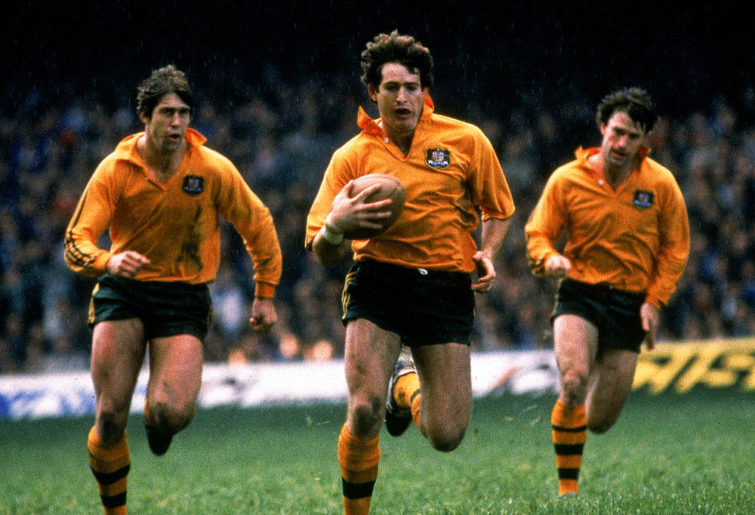
(Getty Images)
Or have brought back Bill in 1999 had Horan defected five years earlier? Almost certainly not.
It’s reasonable to assume that all three feel they made the right decision. None would enjoy quite the status they do today had they left rugby for league.
This, of course, was the amateur era, when rugby players played for love not money – at least in theory.
Now, professional players get to have their cake and eat it too. Those at the top can represent their country and get paid for it. Generations of amateurs must wish they’d been so lucky.
Of course, it’s not money for nothing. Professionalism demands as well as gives, in terms of training time, a demanding travel schedule, marketing and media commitments, not to mention public scrutiny. Still, for many of Australia’s professional rugby players (although not all), it’s a comfortable living.
More Rugby
- Who gets to wear gold? Why Dave Rennie is right and Marika Koroibete must choose
- Four more years of Super Rugby? I bloody well hope not!
- Swinton free to play France after avoiding suspension for Boshier hit
- Deconstructing the ball runner’s options
- Wallabies star Kerevi in Tokyo Games squad
David versus Goliath
The issue for Australia is that other countries are offering more than a comfortable living; they’re offering small fortunes. Even middle-tier players are often handsomely compensated, and those at the top of their game – such as Melbourne Rebels and Wallabies wing Marika Koroibete, who may be heading to Japan at season’s end – can double their Australian salary to make a million dollars or more a year.
Rennie has made it clear that Rugby Australia cannot compete with these kinds of salaries, but we already knew that. There was a similar tussle for then-Reds captain Samu Kerevi a couple of years ago, and that was before a pandemic exposed and worsened the parlous state of Australian rugby’s finances.
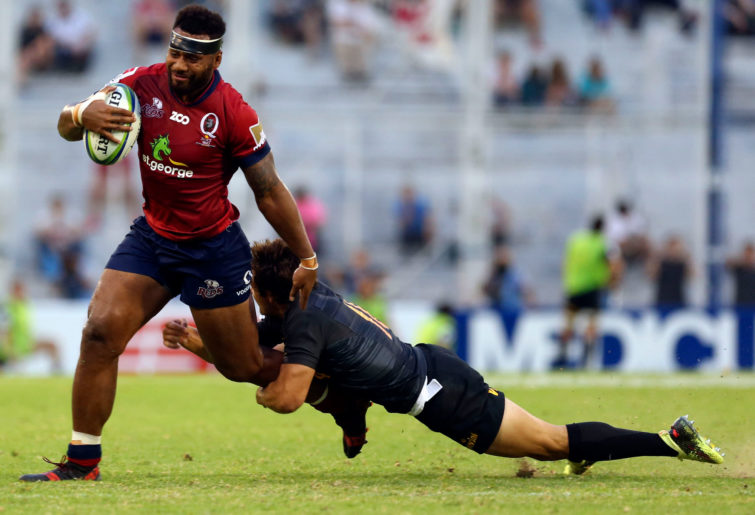
(Photo by Daniel Jayo/Getty Images)
Why on earth Rugby Australia should be expected to compete financially is a mystery. The Japanese Top League sides are the constructs of multinational corporations, such as Panasonic and Toyota. With corporate behemoths behind them, these teams don’t have to sustain themselves. Similarly, the French Top 14 sides and English Premiership teams are often the playthings of wealthy owners.
At the other end of the spectrum, Rugby Australia, and the Australian Super Rugby teams bar the Western Force, are scraping by on broadcast fees, sponsorship money and ticket/merchandise sales. This is David versus Goliath territory.
So why don’t we do as South Africa does and pick our players from anywhere?
Instead of Michael Hooper heading to Japan for five months, he could pack his bags for five years, along with the rest of our top earners, while returning for the approved Test windows. It’s surely an elegant solution that would save Rugby Australia millions each year without compromising the Wallabies.
Gazing into rugby’s crystal ball
The problem with that ‘solution’ is the impact on the quality of our Super Rugby teams with our top players overseas. The problem is the lack of senior players to mentor emerging ones. The problem is the Test coaches’ inability to keep tabs on fitness and form, and the impact on cohesion when the Wallabies come together. The problem is supporters drifting away when players they’ve followed through the pathways disappear. The problem is lost marketing opportunities and fewer sponsors.
Sports opinion delivered daily
In short, the problem is the risk of catastrophic damage to our rugby culture.
The Waratahs’ 2021 season painted a stark picture of what a Super team looks like shorn of its top talent and middle tier, reliant largely on journeymen and a few plucky up-and-comers not quite experienced enough to demand the big bikkies overseas (but who will be gone next year or the year after once their stature and price has risen).
Imagine if all five of our Super Rugby teams had a similar composition (and similar results) to the Waratahs. Is that what we want, year after year, a constant merry-go-round of rebuilding, losing our best and brightest just as they approach their peak?
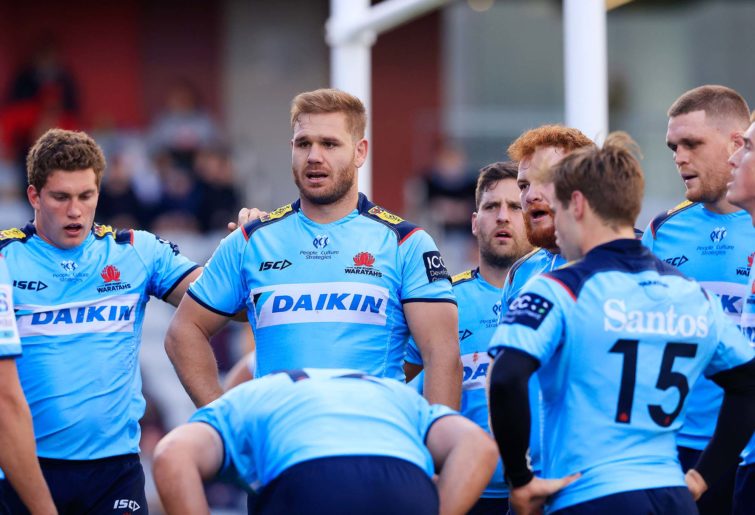
(Photo by Mark Evans/Getty Images)
But onto the impact on Test rugby and, ultimately, Australia’s prospects at the Rugby World Cup.
A multitude of factors go into winning a World Cup. A handful of World XV players, a coaching group able to form a team that’s greater than the sum of its parts, personalities and playing styles gelling, timing and a little bit of luck are just a few.
But my guess is – and it is just a guess – that it would become much harder with our top players based offshore.
Wallabies coaches and medical staff would have little oversight. Players would be less familiar with each other, impacting cohesion. They’d be strangers to the public too, no longer inspiring the same goodwill they once enjoyed. These things matter.
South Africa did it, though
South Africa’s rules relaxed in 2017 to make overseas internationals with 30 Test caps eligible for the Springboks, before restrictions were dropped altogether just a few months before the 2019 Rugby World Cup. 60 per cent of its squad for the tournament was still based in South Africa, so it’s reasonable to theorise that cohesion was still strong.
But what will the impact of a big foreign legion be on the Springboks’ chances of defending their world crown in 2023 – or even on their prospects against the British and Irish Lions this year?
Perhaps, by 2023, all the top South African players will be clustered at Sale and Munster, and cohesion will be just fine. But if your 33-man squad comes from 28 different teams located in seven different countries, they may no longer be speaking the same rugby language. Is the limited time you have together enough to reconnect, or are you now at a distinct disadvantage?
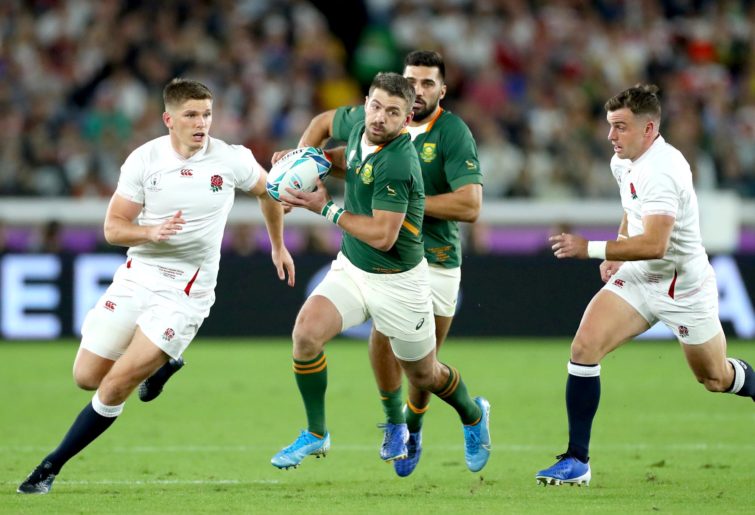
(Photo by Hannah Peters/Getty Images)
Perhaps more important, though, will be the impact on rugby’s place within South African culture. Will it lose its grip on the national psyche? Will the local game become simply a farm league for wealthy overseas juggernauts to plunder? Will kids still aspire to be Springboks?
We simply don’t know. The real effect of changes to eligibility may not be felt for a decade or more. Think of the decision back in 1995 to put Super Rugby on pay TV, and its impact on Australian rugby across a quarter of a century. By the time the true impact of ending eligibility restrictions is known, it may be too late to turn the tide.
Guardians of the game
Rugby is more fragile in Australia than it is in South Africa. Here, it’s a niche sport (albeit one known for punching above its weight) and has to compete with two behemoths in rugby league and AFL. Our unique challenges mean that Australian rugby’s guardians – from the administrators to the players to the fans – must nurture our code with great care.
This is why rugby administrators first moved to give the sport a national footprint. They knew that if they didn’t take the ground others would. As a result, rugby now spans the breadth of our country. It’s an extraordinary feat, one achieved at some cost, admittedly. It places big demands on playing resources while new pathways are established. The politics have been messy, the financial cost near disastrous.
Nevertheless, our youngest team, the Melbourne Rebels, is now ten years old, and the Western Force is 15. In Perth, the Sea of Blue – including cheerleader-in-chief Andrew Forrest – dug in and refused to let the Force die, even when things were at their toughest.
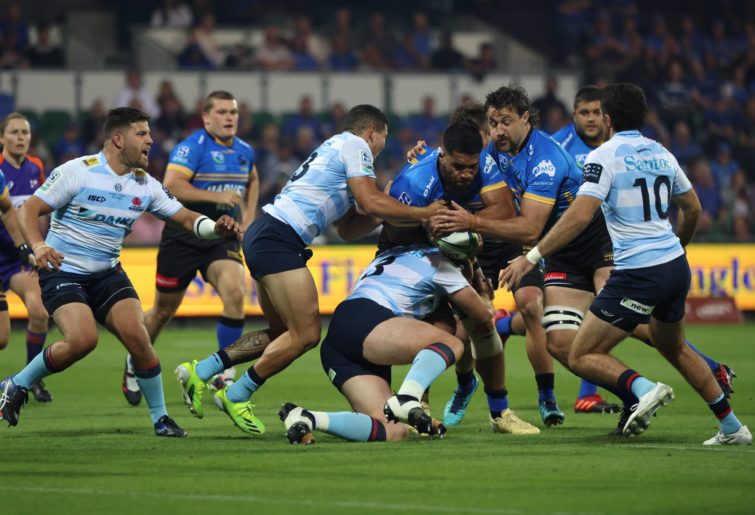
(Photo by Paul Kane/Getty Images)
The Force’s rugby pipeline of homegrown talent has already produced a number of Test-standard players, and in Melbourne the ‘Burn Boys’ are showing the Victorian community what’s possible.
These signs of resilience are significant in Australian rugby’s battle to survive and thrive, but we can’t afford to drop the ball. We need all five Super teams to be strong in order to build awareness, participation and sustainability (not to mention competitiveness at the trans-Tasman level!), just as we need the Wallabies to be competitive, cohesive and strongly supported. This means the best Australian players staying home as much as possible during the peak years of their careers.
There’s some value in short-term overseas stints. Michael Hooper’s low-key sabbatical in Japan will surely have recharged those Energizer batteries, while Matt Philip’s recent French lessons may prove invaluable in the upcoming series against Les Bleus.
Rennie has flagged a place for these kinds of arrangements going forward, for players broadly committed to Australian rugby. Where there’s a benefit for player development, wellbeing and longevity, it’s a pragmatic move.
The ultimate prize
In general, though, Rennie is right to send a strong signal to three-storey Rory and co – indeed, to the entire rugby community – that Australian rugby puts a high value on loyalty. If you want to play for Australia, you must play in Australia.
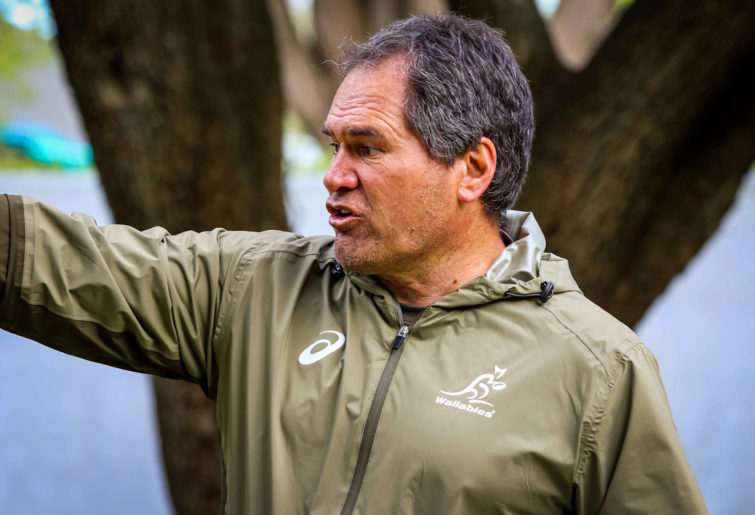
(Andrew Phan/supplied by Rugby Australia)
Of course, when players are loyal and making a financial sacrifice to keep Australian rugby strong, Australian rugby must show loyalty in return. This means providing exciting competitions, world-class coaching and development opportunities, the best medical and welfare support and preparation for life after rugby, as well as the ultimate prize of Test eligibility.
Until Marika Koroibete shows his hand, we won’t know if what Australian rugby offers is enough to keep him here for less money than he’d earn overseas.
Will he want to build a legacy with the Rebels? How badly does he want to win Bledisloes and a World Cup? Does he consider himself part of the fabric of Australian rugby?
His often thrilling performances over the past two years in particular have already repaid Australian rugby’s investment in him. If he chooses to go, it should be with our well wishes.
But before he makes a decision on his future, he might want to speak with Samu Kerevi. In 2019, Samu left for Japan where his brothers were based – and for a financial deal beyond anything the Queensland rugby union and Rugby Australia could offer. It might have seemed a simple decision at the time, a contract that could set up his family for years, if not life.
But anyone who saw Kerevi’s grim expression as Australia raised the Puma trophy following his last game at Suncorp Stadium might have speculated on his feelings. Perhaps they were just end-of-an-era emotions. Or just maybe the true cost of his choice was sinking in.
Wearing Wallaby gold has meaning, more so when you’ve made a sacrifice to do so. Those players from the amateur era who resisted league’s lure were prepared to make that sacrifice. Today’s Wallabies must do likewise.
Original source: https://www.theroar.com.au/2021/06/19/who-gets-to-wear-gold-why-dave-rennie-is-right-and-marika-koroibete-must-choose/
Wednesday, June 16, 2021
Tipping panel – the Final: North versus South
The Super Rugby trans-Tasman Final is upon us, and it’s a battle of the extremities, with the blue team from the top of the North Island against the blue team from the bottom of the South Island.
North versus South. A real Yankee doodle dandy.
I looked back at everyone’s prediction for the Finals a few weeks ago, and none of us picked the Blues and Highlanders getting through to the last weekend of Super Rugby. But neither did you guys!
I scanned through all the comments, and I couldn’t see any Blues-Highlanders predictions there either. So at least we’re all in good company; none of us seem to know what we’re talking about.
For the Final, we’ll offering up a tip and Sure Thing as usual, along with a winning margin and a first try-scorer. Feel free to throw in your suggestions down below.
But the big question this week is whether Harry and Dan fall to opposite sides of this contest? Will we finish with an overall winner, or another tepid draw like last year?
More Rugby
- Tipping panel – the Final: North versus South
- I would rather watch an All Blacks trial
- How many Waratahs will be selected for the Wallabies?
- Why the sting is in the tail at lineout time
- Pro14, South African rugby clubs form United Rugby Championship
My thanks to guys for ripping into another year of tipping, some of which was even pretty good. And personally speaking, it was great to be able to jump back in the chair late in the season, too.
Stay tuned for what we’ve got in store for the July Internationals and the last of the great rugby tours: the British and Irish Lions once again leaving the Home Nations, this time for South Africa.
LAST WEEK: Digger and The Crowd 5; Brett 4; Harry, Dan, Geoff 3.
OVERALL: Harry and Dan 55, The Crowd 53, Geoff 50, Digger 49, Brett 45.
Digger
Short and sharp this drag race of a Trans-Tasman competition has found the two most consistent sides facing off for a second chance at a 2021 trophy: the glamour of the Blues versus the graft of the Highlanders.
For me, I think the Highlanders will get across the line.
I believe they play with more cohesion and certainty around their game plan, and handle and absorb pressure better than their northern counterparts.
And along with rumours swirling around who may or may not be available for the Blues this coming weekend has me further entrenched into the Highlanders camp.
Having Aaron Smith helps too.
TIP: HIGHLANDERS by 12
FIRST TRY: Kazuki Himeno
SURE THING: The Blues will continue their fine tradition set by Dan Carter by having another World Cup winner waterboy in Beauden Barrett ferreting about.
Brett
Raising our predictions for the Final from a few weeks ago rams home how far off the mark I’ve been in 2021. I had the Chiefs meeting the Crusaders in the Final, and what actually happened was the Chiefs fell in hole, and the Crusaders’ world imploded on them after winning a game by four tries.
But it was hard to be anything but impressed with the Highlanders watching them up close last week. Well, that is, once I could work out if which team was running which way in the flood of white jerseys.
And I say that because obviously, nothing about the Blues impresses me!
That said, I am really looking forward to this game. It won’t really matter if Otere Black is out of action, because the Blues scrumhalves tend to just find the nearest big bloke with a single digit coming around the corner.
If Black played for the Highlanders, Aaron Smith would knock the thermometer out of his mouth from thirty metres away off his left hand. And before Otere would even realise the ball was coming.
So two contrasting styles. Or about as contrasting as the Kiwi sides get.
TIP: Highlanders, obviously. By 7
FIRST TRY: Aaron Smith. For the Brotherhood.
SURE THING: I feel like I should be exempt from this when the Blues are playing.
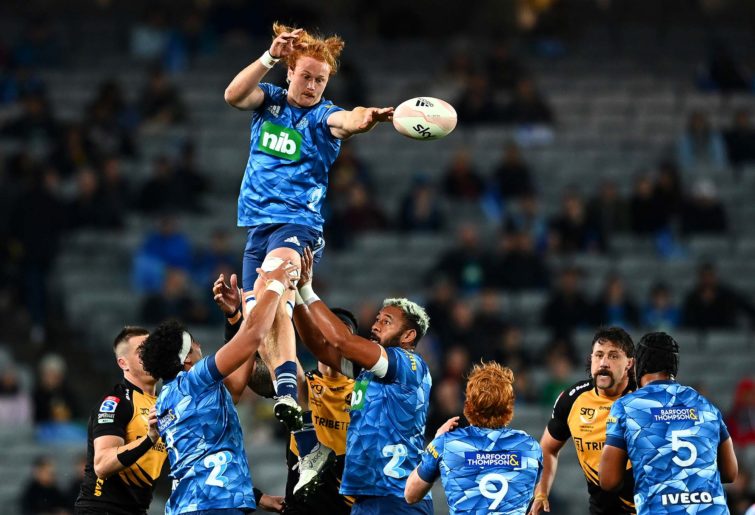
Tom Robinson. (Photo by Hannah Peters/Getty Images)
Harry
The best player on the pitch will likely be a Highlander.
The shrieking screams of Aaron Smith are horrendous (imagine how it sounds in the close confines of an airport loo), but he is still the best scrumhalf in rugby, despite strong challenges by Faf de Klerk and Antoine Dupont.
Faf is a defensive maestro and Dupont an extra loose forward, but Smith still throws the longest, strongest, straightest passes, to the best targets, and so, he will probably keep the South Island mob in touch, for a while.
But in the end, the big bold Blue bullies will have too much: too much aggression, pace, championship pedigree, and reserves.
They will find space, and score. The Clan will score too, but not enough. Blues by 12. The bigger Ioane to dot down first.
TIP: BLUES by 12.
FIRST TRY: Akira Ioane.
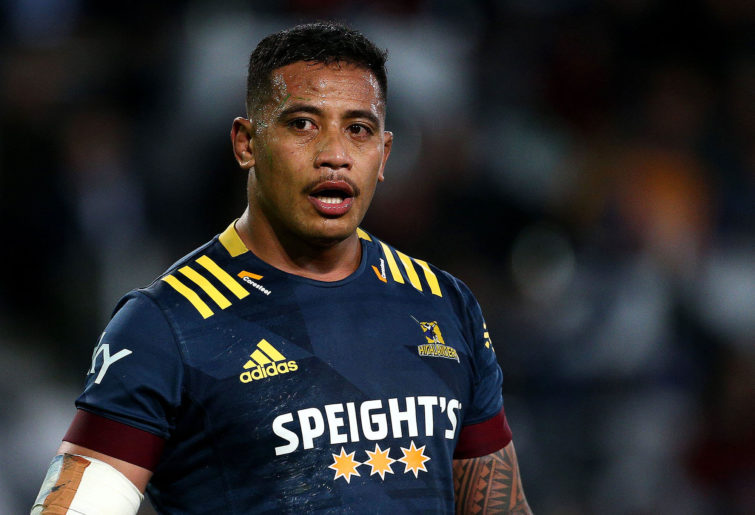
Shannon Frizell. (Photo by Dianne Manson/Getty Images)
Dan
There’s only one pick this week: the Highlanders to snag an upset win in the final.
The reason? Well, it would be very boring if the two best tipsters on the panel went the same way for the final round of the season rather than allowing us to have a clear winner.
Which is to say, Aaron Smith will once again fire perfect, pinpoint passes all around the field to mastermind a victory. The Landers’ lineout will run like precision clockwork, and their team effort (with the help of Smith) will outclass the greater individual talents of the hosts.
TIPS: HIGHLANDERS by 2
FIRST TRY: Ash Dixon
SURE THING: After last week’s debacle, the Highlanders will be sure to avoid wearing their away kit again and therefore don a lovely shade of navy for the decider. Which is obviously very different to Auckland blue.
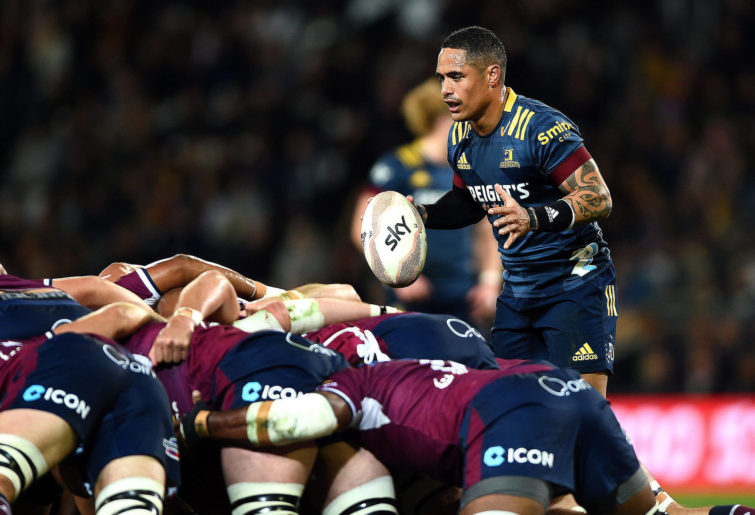
(Photo by Joe Allison/Getty Images)
Geoff
In a chat after the Blues put 50 points on the Rebels in Round 1, Blues coach Leon McDonald fixed a deathly stare and explained to me how they had visited the room of mirrors, admitted their shame and disappointment at not making the SR Aotearoa final, and resolved to make up for it in this comp.
Perhaps I’m easily influenced, but it was entirely believable.
And for that reason, no matter the appeal of Aaron Smith, Jona Nareki and Liam Coltman’s second half precision, dart-like throws, plus the possible loss of the big ginger Tom, it’s redemption day for the Blues on Saturday.
TIP: BLUES by 5
FIRST TRY: Billy Harmon (who will then request a TMO review on himself and have it rubbed out)
SURE THING: The Eden Park crowd will be 8-10,000 below expectations due to fans staying at home, to ensure they don’t miss any of the cricket.
| TT-FINAL | Harry | Brett | Dan | Digger | Geoff | The Crowd |
|---|---|---|---|---|---|---|
| BLU v HIG | BLU | HIG | HIG | HIG | BLU | ? |
| Margin | 12 | 7 | 2 | 12 | 5 | ? |
| First try | A Ioane | A Smith | A Dixon | K Himeno | B Harmon | ? |
| Last week | 3 | 4 | 3 | 5 | 3 | 5 |
| Overall | 67 | 45 | 57 | 61 | 55 | 53 |
Get your votes in now – The Crowd’s tips will be revealed Friday afternoon AEST.
if (!Element.prototype.matches) Element.prototype.matches = Element.prototype.msMatchesSelector document.addEventListener("DOMContentLoaded", function() var request = new XMLHttpRequest(); request.open('POST', '/wp-admin/admin-ajax.php', true); request.setRequestHeader('Content-Type', 'application/x-www-form-urlencoded;'); request.onload = function () if (this.status >= 200 && this.status < 400) document.getElementById("at-submit-tips-inner").innerHTML = this.response; document.addEventListener('click', function (event) if (!event.target.matches('.margin-tap-targets span')) return; var match = event.target.getAttribute('data-match'); var points = event.target.getAttribute('data-points'); var marginField = document.getElementById('at-margin-'+match); marginField.value = marginField.value*1 + points*1; , false); else console.log(this.response); ; request.onerror = function() // Connection error ; request.send('action=at_insert_submit_tips&title=Your Tips&comp_id=8&round_id='); );Original source: https://www.theroar.com.au/2021/06/17/tipping-panel-the-final-north-versus-south/
https://therugbystore.com.au/tipping-panel-the-final-north-versus-south/
Dave Ewers and Sam Skinner: Exeter Chiefs forwards banned for play-offs
Original source: http://www.bbc.co.uk/sport/rugby-union/57494652
https://therugbystore.com.au/dave-ewers-and-sam-skinner-exeter-chiefs-forwards-banned-for-play-offs/
Tuesday, June 15, 2021
Why the sting is in the tail at lineout time
Australian supporters can sit back, relax and take a breath. The pain is over. When all is said and done, two teams from New Zealand – the Blues and Highlanders – will be contesting the first-ever Super Rugby Trans-Tasman final.
The Kiwi sides have dominated the tournament, winning 23 out of 25 matches, and they have offered the Super Rugby AU competition a very dry dose of perspective in the process.
They have held sway in most of the critical areas in the modern game: at the transitional phases in attack and counter-attack, and through their ability to cut corners in all of the contact situations. It has been an education.
The coaching staffs at the other four Australian franchises might want to pause for a moment, and wonder just why it is that the Western Force have enjoyed the most consistent record against New Zealand opposition over the course of the five matches.
Although the Force didn’t win a game, they did at least manage to participate fully in some tight contests, conceding the fewest points of an Australian team (148) and the lowest average points differential: -13 per game, compared to -14 by the Brumbies, -17 by the Reds, -24 by the Rebels and -28 by the hapless Waratahs.
Tim Sampson and co. identified the areas of real need against New Zealand opposition. They had the highest tackling success percentage, at 86: four per cent higher than the next best (the Brumbies) and a massive ten per cent better than the cellar-dwellers, the Reds and Rebels.
In the final round against the Blues, their second-half comeback was triggered by neutralising one of the great strong points in the New Zealand game: the ability to win blue riband ball from the tail of the lineout.
During Trans-Tasman, New Zealand sides threw the ball to the back of the lineout five per cent more than Australian teams (31% to 26%). They were also more successful at winning possession in that area, retaining 85 per cent of ball compared to 81 by their opponents.

Tom Robinson. (Photo by Hannah Peters/Getty Images)
If you can win ball from the tail of the lineout consistently, the advantages in attack are maximised. You get to the midfield much more quickly, and it becomes harder for the defence to manage both sides of the ruck. Their forwards have to run further to reach the openside of the first breakdown, and the line spacings on the short side are wider.
The Force understood that threat from their opponents, winning four consecutive Blues’ throws at the start of the second half. Three of those were directed to the tail:
In all three examples, the two defensive pods are set up towards the middle or back, and the Blues lose three prime attacking positions to steals by Sitaleki Timani and Jeremy Thrush. That gave the Force a foothold in the game that they had previously lacked.
They took their lessons from the previous round against the Crusaders, where they had given up the space on or beyond the 15-metre line much too easily for comfort, and made the necessary adjustment in order to compete effectively:
The Force proceeded to score two tries of their own from back ball just for good measure, and move within touching distance of the Blues:
By way of contrast, the match between the Brumbies and the Highlanders was an object lesson in what happens when you give a team from New Zealand a free pass to lineout ball from the tail.
The Highlanders started with a try from a lineout drive off barely contested back ball:
New Zealand hookers tend to be the premier throwers on the planet to the tail and beyond, and they hardly ever underthrow the receiver. If they make a mistake, they ensure it is too long rather than too short. As the above examples show, the worst outcome for the defence is for the jump to go up too far in front of the receiver and give the Kiwis a free play around the end of the line.
Throughout the game, Highlanders hooker Ash Dixon demonstrated that he belongs in that elite group of throwers:
The dead-straight ball travels more than 20 metres in the air. One simple pass later, the Highlanders are on the edge of the Brumbies’ 22, with the home forwards struggling to reach their defensive positions at the first ruck:
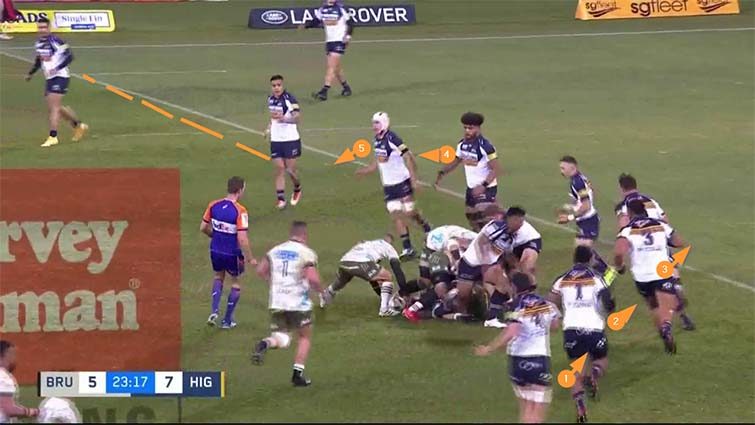
Only two, Rory Scott and Rob Valetini, have managed to wrap because of the depth of the breakdown, while three of the shortside tight forwards are still struggling to make up ground.
A yawning gap has opened between Len Ikitau and Tom Wright on the Brumbies’ right, and this was a scenario the Highlanders were able to exploit later in the half – even with less space available between the two Brumbies:
The pressure from a stream of back ball only grew in the second half:
The tail-gunner, Scott in the white hat, is defending at the middle of the line as the Brumbies’ pod goes up in the air to no avail, giving Pari Pari Parkinson an easy gallop into midfield off another superb delivery from Dixon:
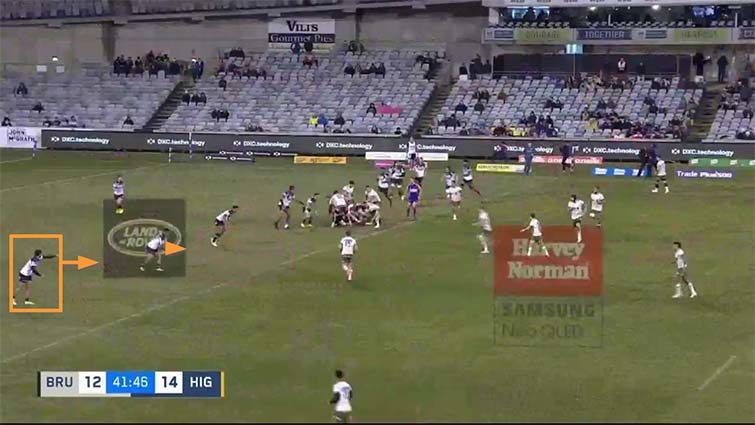
The rest of the defence begins to compress like a concertina, with Tom Wright already positioned five metres inside the far 15-metre line after just one phase of play. It is hard to recover your width on defence from such a beginning.
More easy back ball courtesy of Bryn Evans, more problems for the Brumbies’ outside defence off an attacking chip by Highlanders flyhalf Mitch Hunt.
When the coup de grace finally arrived, it was only right and natural that it should be delivered off uncontested tail ball:
With the ease of transfer between Dixon and Evans, Evans and Josh Dickson, and Dickson to Billy Harmon, it all looks far too much like a training ground exercise brought to life with minimal interference from ‘the vests’.
But the real question has already been posed by the slick delivery of ball from the back of the line, which has widened the gaps and thinned out the forward defence:
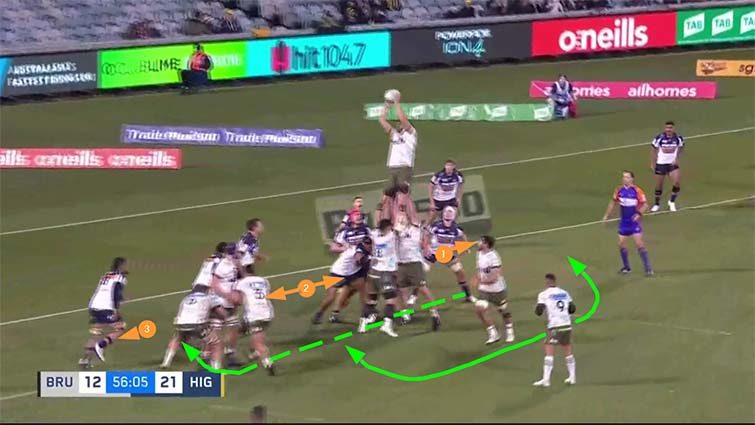
The Highlanders could send Aaron Smith around the end, or through the middle of the line on a ‘teabag’ just as easily, but they eventually opt for Harmon around the front, scoring the try unopposed.
Summary
The Trans-Tasman tournament has illustrated the drawbacks of domestic isolationism in Australia in brutal fashion. All of the Australian teams have found the transition to New Zealand skill levels, changes of tempo, and refereeing perceptions far too much to handle.
Of the five franchises, the Force have responded to the challenge most successfully, particularly given the limited playing resources at Tim Sampson’s disposal. If, by some magical smattering of fairy dust, they could have added the likes of Samu Kerevi and a fit Dane Haylett-Petty to their back-line, they would have finished top of the Australian segment of the table.
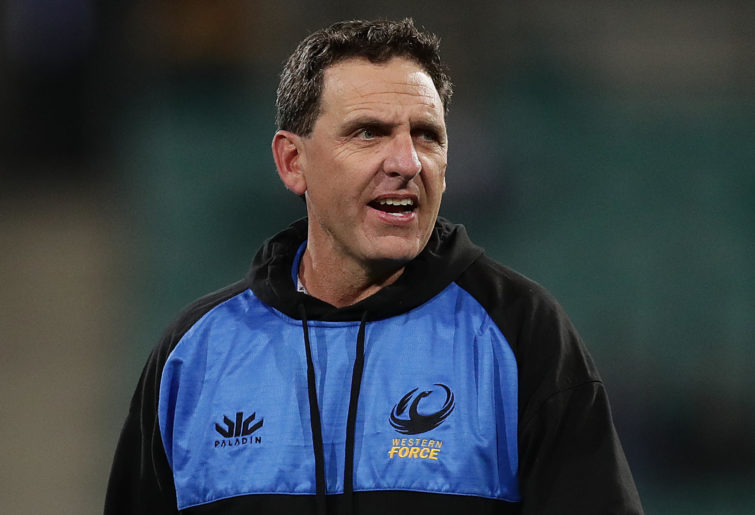
Tim Sampson. (Photo by Mark Metcalfe/Getty Images)
They have defended better than anyone else in Australia and played a mature possession-based game with ball in hand. They kept scores close, even with more moderate scoring potential than all of the other four franchises. They understood the strengths of the opposition and tried to put sensible counter-measures in place.
With three July tour games against France to be followed in rapid-fire succession by another three versus the All Blacks in August, Wallabies head coach Dave Rennie will be acutely aware of the need to move beyond domestic back-patting in order to get on even terms with the big boys of the global game.
He will know all about the threats posed by New Zealand teams in particular. The sting in the tail, whether it occurs from the lineout or elsewhere, should not come as a surprise.
As the great Green Bay Packers quarterback Aaron Rodgers put it, “For me, it’s always been about preparation, and the more prepared I can be each week, the less pressure I feel, and the more confident I am. As your confidence grows, it’s only natural that the pressure you feel diminishes.”
Amen to that.
Original source: https://www.theroar.com.au/2021/06/16/why-the-sting-is-in-the-tail-at-lineout-time/
https://therugbystore.com.au/why-the-sting-is-in-the-tail-at-lineout-time/
Pro14 becomes United Rugby Championship as South Africa sides join tournament
Original source: http://www.bbc.co.uk/sport/rugby-union/57475511
Monday, June 14, 2021
The coaches want it, and now it seems RA’s appetite for the NRC might be growing
It didn’t get much traction on the east coast, but comments from Western Force coach Tim Sampson in a Nick Taylor article in The West Australian last week added yet more weight to a growing sentiment in Australian rugby.
“We had seen enough of Ollie over the last year or so to back him, but without a second-tier competition there is an element of risk for some players jumping from club rugby to Super Rugby with nothing in between,” Sampson said of young backrower Ollie Callan, who earned his first starts for the Force in the final games of Super Rugby trans-Tasman.
“Certainly, there is a bit of the unknown and it’s a huge step for some players who might be thrown into the deep end when they might not be quite ready.
“Without a two-tier competition there is a gaping hole. It is an extremely important stage in a player’s development,” Sampson said.
It’s a pretty obvious statement based on plenty of evidence just this year alone. Callan has made a pretty good fist of Super Rugby so far, and so has someone like Isaac Henry with the Queensland Reds.
But for every Callan and Henry, there’s someone like young Brumbies prop Archer Holz, and Waratahs winger James Turner, hugely talented players both of them, but they quickly learned just how big a step it now is from club rugby to the professional level.
Holz, at least, had been training with the Brumbies squad as a rookie pro; Turner and several other Waratahs call-ups in this season of injury hell were just plucked straight from first grade.
Tim Sampson’s comments were accurate, but the accuracy was only part of it. More significant was the fact that he was now the third current Australian Super Rugby coach – of five – to publicly lament the loss of the National Rugby Championship last year.
Now, the reasons for the NRC’s demise are obvious: Rugby Australia simply couldn’t afford to run the competition in the face of brutal and necessary cost-cutting. Even if they wanted to play the NRC last season, there were simply much higher financial priorities.
In many ways and to many people, it was a convenient casualty of a pandemic that impacted the governing body’s finances like they’d never been hit before.
More Rugby
- The coaches want it, and now it seems RA’s appetite for the NRC might be growing
- James O’Connor is a centre
- Australian rugby must learn the lessons of the 2013 Brumbies
- The New Zealand cricket-rugby XV
- Five talking points from Super Rugby Trans-Tasman, Round 5
But while the reasoning for discontinuing the NRC were understandable, the impact of not having that vital development bridge between Premier Rugby around the country and the Super Rugby programs hit home far quicker than was perhaps anticipated.
All five states were hit by injuries at different times, forcing them to call in injury replacements and granting hurried opportunities to academy and club players well before they would normally be declared ready. The Brumbies used 37 players through Super Rugby, and the Waratahs’ tally is quite likely higher.
Only a week before Tim Sampson had his say, Reds coach Brad Thorn had already made his view clear.
“The thing I’ll say is, my concern, is not having the NRC, this is the second year now,” Thorn said a few days after the Reds beat the Chiefs in Townsville.
“And you look at the Crusaders, they’ve got Tasman and they’ve got Canterbury, two of the strongest teams in the NPC, plus the academy.
“And for us we had (Queensland) Country and (Brisbane) City and you look at all our players who have come through that middle ground between club and Super.
“So not having the NRC, to me, it’s a tough one. Something has to be done.”
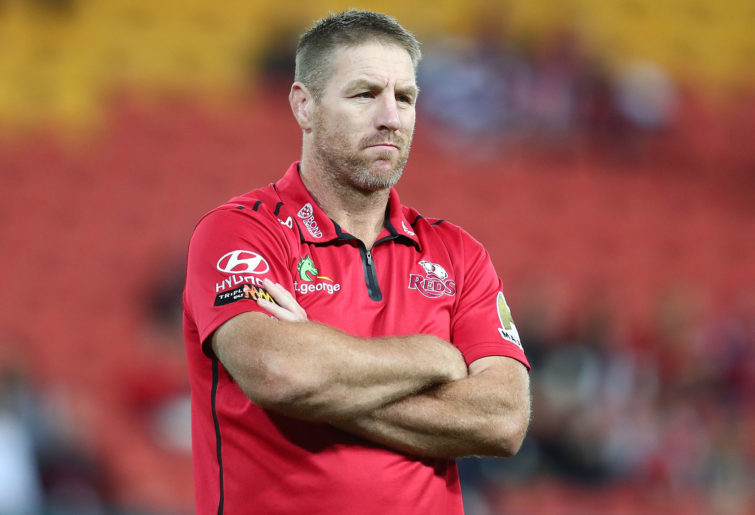
Brad Thorn. Down with N-P-C. (Photo by Chris Hyde/Getty Images)
McKellar has been on this same page for some time, though takes a view that whether it’s something like the NRC or something that brings existing clubs together on the national stage, it doesn’t matter. But something is still needed to bridge the ever-increasing gap.
Back in late April, he again raised the idea of an FA Cup-style national knockout competition that was first raised more than a year ago as the broadcast negotiations heated up.
“Having that next tier of competition is important moving forward. I think that is fair, then everyone is involved and the best survive,” the new Wallabies forwards coach said at the time.
“You’ll get your upsets which will create a whole lot of interest, like we see in soccer both overseas and in Australia. We see who the best of the best is.”
When three of the five coaches are saying player development is now harder without an NRC or some other competition in its place, you’d like to think their concerns were being heard at head office. But there hadn’t been much evidence that that was the case.
You can imagine my surprise, then, when RA CEO Andy Marinos was suddenly and enthusiastically agreeing with Thorn and the other coaches, even lamenting the fact that without that next tier competition, Australia will only continue to drop further behind New Zealand, South Africa, and even England and France.
“He’s (Thorn) not wrong, he’s not wrong,” Marinos told Christy Doran for an article on the Fox Sports site.
“If you look at any great structure in the world, there are those competitions and it’s a part of what I’ve been saying since I’ve come in. We’ve got to have a bottom-up approach, not a top-down approach to the game in this country if we’re going to be sustainable.
“As we start embarking on a new strategic plan and a new strategic direction, the competition structure of having a second-tier competition – for want of a better word – that underpins what’s happening at Super Rugby level is going to become even more important because we have a group of players who play Super Rugby and can drop back into the Shute Shield and Hospital Cup but then after those competitions finish there’s very little rugby for them.”
Marinos went on to say that competition structures were being floated and determined, and that “I’d like to look at getting a second-tier structure underway in 2022 at least, so we can start building momentum”.
Getting Australia’s rugby structures right were also going to play an important role in building toward RA’s bid to host the 2027 Rugby World Cup and, you could safely assume, cashing in on and benefiting from the event thereafter.
“If we can have that by the time we have the World Cup in 2027 and we have a flourishing first, second and third-tier domestic rugby competition structure, I think that would be a really big statement for the game,” he said.
Well, colour me shocked.
This was the first public utterances I’d seen from anyone with the highest levels of Rugby Australia over the last year that were different to the very public position that utilising and strengthening existing Premier Rugby clubs around the country was the best way forward.
Marinos’ comment, that “it’s a part of what I’ve been saying since I’ve come in” made my ears prick up too.
Because that wasn’t the vibe I got when I raised the future of the NRC during a meet-and-greet discussion with Marinos I was part of in Canberra back in February.
Promoting the game at the community and club level around the country, strengthening club comps in Canberra, Melbourne, and Perth so that they were not too dissimilar to the levels in Brisbane and Sydney, and looking at ways of bringing existing clubs together on a national stage was very much the plan, Marinos told us, which was consistent with what Chairman Hamish McLennan had been saying since he’d come in earlier last year.
So, if Marinos had been talking about implementing – or reinstating, more accurately – a next tier competition in between club and Super Rugby, he’d not been saying it much. Because no-one from Rugby Australia had been.
Sports opinion delivered daily
Hence my surprise at his comments now.
I’ve maintained ever since the demise of the NRC that I would be pleasantly surprised if it ever returned, and that remains the case.
Even with Marinos now seemingly putting it back on the agenda, I remain hopeful rather than encouraged, and still a long way short of confident.
But the fact it is back on the agenda and up for discussion again, at least, is a very welcome development, for fans, players, and coaches alike.
Original source: https://www.theroar.com.au/2021/06/15/the-coaches-want-it-and-now-it-seems-ras-appetite-for-the-nrc-might-be-growing/
Dave Ewers: Exeter flanker cited for dangerous tackle after Sale yellow card
Original source: http://www.bbc.co.uk/sport/rugby-union/57470278
Sunday, June 13, 2021
Championship play-off final: Ealing Trailfinders 0-60 Saracens - Ruthless Sarries close in on Premiership return
Original source: http://www.bbc.co.uk/sport/rugby-union/57443588
Five talking points from Super Rugby Trans-Tasman, Round 5
And then there were two – and perhaps not the two we all expected. The final round of the trans-Tasman competition has been and gone, and the suffering of Aussie fans can finally stop – well until the Bledisloe at least.
The results this weekend might have been expected – another clean sweep for the Kiwi sides – but there’s plenty to talk about, so let’s get stuck in.
Brad Thorn will be ropeable
You wouldn’t want to be around Brad Thorn much this weekend after Friday night’s game. Take your pick of reasons why. My best guess is that while he might want to rip the referee a new one for the two yellow card decisions – more on them later – it’ll be his own players that he’s most frustrated by.
Forty-eight missed tackles – 48! Just think this through for a second – the Hurricanes had only 41 per cent of the possession. The ball is in play for roughly 35 minutes out of the game. The Canes therefore had the ball in hand for 15 minutes in the whole game. In those 15 minutes the Reds missed a tackle at a rate of one every 20 seconds.
A Brad Thorn-coached side that misses a tackle every 20 seconds is in for a brutal conversation on Monday morning.

(Photo by Chris Hyde/Getty Images)
How in the name of all that is good and pure was that a penalty try?
The Queensland players might be quite glad that their coach’s fury at them will be diluted thanks to some incredibly poor decisions from the referee.
The penalty try against Bryce Hegarty was absolutely bonkers. You can agree that the 28-year-old knocked the ball out of play deliberately, you can even agree that this behaviour deserved a yellow card, but you simply cannot be sure that Ngani Laumape was going to score.
It just doesn’t make sense. To award the penalty try the referee has to believe that if Hegarty had not committed the illegal act, then Laumape would have scored. But considering that the act was that Hegarty knocked the ball out deliberately, you are saying that the Reds player got to the ball and was able to touch it.
So if he got there, how can you say that Laumape would have scored? Surely you have to say that actually if Hegarty had chosen not to knock the ball out, then he still could have stopped Laumape from scoring and therefore no penalty try can be given.
Sports opinion delivered daily
Will Rugby Australia feel the Force to changing their minds?
No Australian side has really covered themselves in glory over the past five weeks, but the Force should look at the trans-Tasman competition and take a lot from their progress. Just like in the Australian competition, they finished behind the Reds and Brumbies but ahead of the Rebels and the Waratahs. They had the least bad points difference of any of the Aussie sides and conceded the fewest points of all their domestic opponents, partly thanks to them also having the best tackle completion rate of any of them, at 85.8 per cent.
Their discipline was good and their set piece not too bad, and they managed to perform at roughly the same level whether home or away.
The area they struggled with was racking up points and really punching holes and gaining metres when they had the ball. They didn’t make too many errors, but they never really scared defences either in close or out wide.
But there is talent among the backline players and experience in key positions. If they can add some more effective ball carriers in the forwards, then the future will be looking good.
It’s worth remembering that the Force brought in a load of new players this season, and to see them perform in this way in their first campaign together should give hope to Force fans. They have shown that they can be difficult to beat. Next season they need to add in some more attacking threat – if they do, they will trouble the Brumbies and Reds again.
Meanwhile, over in Melbourne, the management must be a little bit worried about what’s happening. Not only have they had a shocking season – poor on the field in another season of no progress, and they’ve lost a coach and have had to be away from home far too often – but the powers that be must be looking at the structure of the competition again and wondering whether the Rebels really have a future at the top level of the domestic game.
The Waratahs have had an even worse season than the Rebels on the scoreboard, but they have the advantage over their Victorian cousins of being able to claim that they’re in a genuine rebuilding period and that they have a far more attractive market around them in New South Wales than the Rebels do in Victoria.
With two new Pacific sides joining the competition soon, the Rebels will know that they can’t afford another season at the bottom.
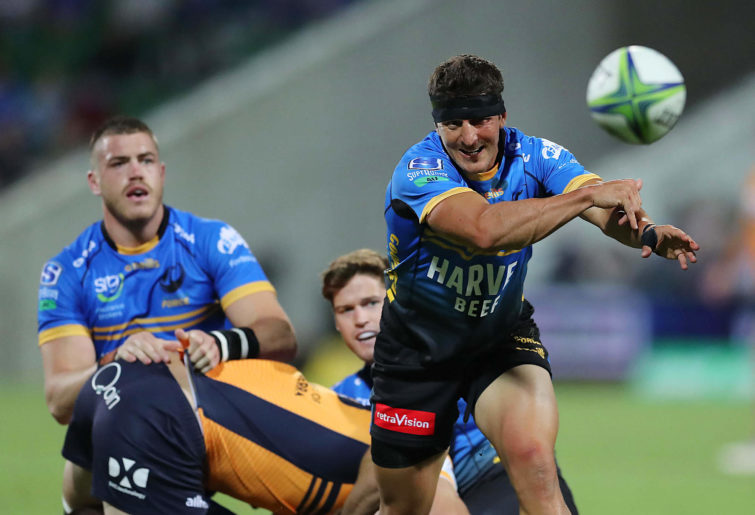
(Photo by Will Russell/Getty Images)
A Super Rugby final without the Crusaders
The Crusaders are without doubt an incredible side – they would run most international sides close and pick up a number of wins if they went on a world tour.
But having a Super Rugby final without them is actually pretty exciting – even for Australian fans. It’s not that the machine from Christchurch plays boring rugby – they have some wonderfully creative players throughout their ranks – but sometimes it just gets a bit boring to see the favourites play well and win over and over and over.
With the Blues and the Highlanders coming together in the final we’ve got a much more exciting story. The Blues haven’t won a title for 18 years and the Highlanders have so often been cast as the plucky underdogs who everyone likes but no-one bets on to get the win.
The Highlanders are more of a surprise presence in the final, with the Blues finally living up to expectations. But when you look at the stats, it really shouldn’t be that much of a surprise.
They’ve scored 30 tries in the trans-Tasman competition and averaged almost one more try per game than the Blues backed by having two of the top four try scorers in the whole tournament.
They have a higher tackle completion rate, they’ve won the most lineouts in the competition and they have the best discipline out of any of the ten sides.
So the Blues might go into the final as favourites, but the combination of pressure and an in-form Highlanders side could well be their undoing at the final hurdle.
More Rugby
- Five talking points from Super Rugby Trans-Tasman, Round 5
- The Wrap: Five-try Wainui reveals Super Rugby’s bald truth
- Get your questions in for Issue 17 of Coach's Corner
- Super Rugby AU: The third tier
- Dave Rennie reveals his Wallabies squad to take on France
And the brain fade of the round goes to Lachie Swinton
Is Dave Rennie the only one who thinks that Swinton’s hit on Lachie Boshier didn’t deserve a red card? The Wallabies coach tried to justify the Waratahs backrower’s behaviour by saying, “He certainly didn’t have a big run-up in and he’s just trying to get in”.
Come on, Dave. It was a terrible hit. The guy had already hit the ruck and then reloaded and hit Boshier clear in the side of the head.
Now, of course we all know that one of Swinton’s plus points is the aggressive style he brings to the game, but his hit against the Chiefs wasn’t the aggression the Tahs or Wallabies need. It was a dog hit late in a game when the NSW side had already got the penalty and that the Tahs had already lost by miles. There was nothing to be gained other than hurting one of the opposition, and he must have known that there was a chance that he would make the final five minutes of the worst season in the club’s history that little bit harder for his teammates.
Opposition sides won’t have looked at that and thought, “Wow, I hope we don’t have to run out against him!”.
They’ll have seen it, smiled and started thinking about how quickly they can wind him up and get him off the pitch. Fortunately Rennie has other good options in the back row, but it’s such a shame to see the Tahs’ season end on such a sour note.
Original source: https://www.theroar.com.au/2021/06/14/five-talking-points-from-super-rugby-trans-tasman-round-5/
https://therugbystore.com.au/five-talking-points-from-super-rugby-trans-tasman-round-5/
Saturday, June 12, 2021
Premiership: Exeter Chiefs 20-19 Sale Sharks - 14-man Chiefs fight back to seal home semi-final
Original source: http://www.bbc.co.uk/sport/rugby-union/57439127
Chiefs consign Waratahs to winless season
The NSW Waratahs have endured a winless Super Rugby season for the first time after falling 35-7 to the Chiefs in Sydney.
Winger Sean Wainui bagged four tries as the Chiefs consigned the Waratahs to an unprecedented winless campaign with a record-extending 13th straight defeat on Saturday night.
A dislocated shoulder to classy centre Izaia Perese only compounded the Tahs’ woes and provided a selection headache for Wallabies coach Dave Rennie in the process.
Far and away the Waratahs’ best performer this year, Perese would almost certainly have been named in Rennie’s squad on Sunday for the looming three-Test series with France.
But the powerhouse midfielder came off a sorry second-best after a late first-half tackle on Chiefs opposite number Alex Nankivell.
“It (the tackle) didn’t have to be made,” former Wallabies coach Michael Cheika said during commentary on Stan.
“We saw it previously in some of the clips – Izzy Perese going in making tackles he doesn’t need to.
“And if you see it, he’s looking for the big contact – no grip, no arm around – so it’s really unfortunate because’s been very talismanic.
“He’s made some great breaks tonight even for the Tahs. Very disappointing.”
While tossing up the likes of Hunter Paisami or moving Matt Toomua into the centres, Australia’s two-time World Cup-winner Tim Horan urged Rennie to blood 22-year-old Brumbies Len Ikitau instead.
“I actually think you need to start looking to the future,” Horan said.
“You know what Matt Toomua can do. I think you put the young kids in and give them a crack early on.”
As they have been in many other games this year, the Waratahs were gritty against a Chiefs outfit also out of finals contention.
The youthful Tahs showed a glimpse of their promise when fullback Mark Nawaqanitawase soared high to reel in a well-placed cross-field bomb from flyhalf Will Harrison just before halftime.
Their lone try reduced the deficit to 14-7.
But two more tries after the break to Wainui, followed by the Chiefs’ fifth try through replacement Tom Florence, sealed the Waratahs’ fate.
Back-rower Lachie Swinton faces a possible suspension and omission from the French series after being red-carded late on for a careless tackle on Chiefs flanker Lachlan Boshier.
Original source: https://www.theroar.com.au/2021/06/13/chiefs-consign-waratahs-to-winless-season/
https://therugbystore.com.au/chiefs-consign-waratahs-to-winless-season/
Friday, June 11, 2021
Brumbies fall to Smith-led Highlanders
The Brumbies have failed to take a second Kiwi scalp, disappointingly falling to the Highlanders in their Friday night Super Rugby Trans-Tasman clash in Canberra.
The Australian heavyweights were hopeful of backing up last week’s win over the high-flying Hurricanes, but were outplayed 33-12.
The bonus point win sent the men from Dunedin to the top of the ladder, with the two leading teams at the end of the round playing off in the final next Saturday.
All Blacks halfback Aaron Smith orchestrated the victory with a try in each half while he also set up another for winger Sio Tomkinson and was delighted to finish the regular season without a loss.
“I’m over the moon, a little bit shocked,” Smith told Stan Sport.
“In that last six minutes we did everything to give the game away and I’m really proud of the boys to hang in there.
“We’ve given it our best shot to make the final – we’ve won five in a row and I’m absolutely pumped.”
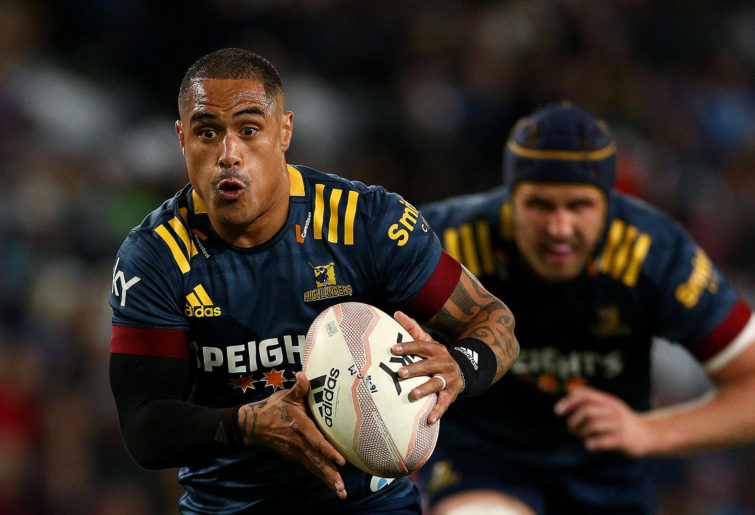
(Photo by Dianne Manson/Getty Images)
The Brumbies were right in the contest at halftime, trailing 12-14, but didn’t rise to the challenge in the second stanza at GIO Stadium.
Smith darted across the line from the back of the scrum to inflict the first wound in the 46th minute.
While the Brumbies pride themselves on their set-piece they were outsmarted at a five metre line-out when the Highlanders found Billy Harmon on the short side.
And then Smith, New Zealand’s most capped halfback, threaded a pass to Tomkinson to score their fifth try of the night and crucially put the Highlanders into bonus-point territory.
More Rugby
- Brumbies fall to Smith-led Highlanders
- Reds fail to make final-round statement
- It's time to sort out Trans-Tasman kit clashes
- ACT Brumbies vs Highlanders: Super Rugby Trans-Tasman live scores
- Hurricanes vs Queensland Reds: Super Rugby Trans-Tasman live scores
The Brumbies did their best to spoil their opponents’ finals hopes with a late try but couldn’t find their way to the line.
Earlier Brumbies hooker Lachlan Lonergan boosted his Wallabies selection chances with a try from a rolling maul.
Centres Irae Simone and Len Ikitau also combined for a first-half try to press their claims for a call-up for the Test squad to face France next month.
“It was a tough way to end the year,” Brumbies skipper Allan Alaalatoa told Stan Sport.
“In the first half we thought we had the momentum but the Highlanders coming out and scoring two quick tries in the second half really hurt us.
“It’s been a huge learning for us – we’ve come away with one win in the competition so in terms of the review we’ve got to understand ways we can get better for next year.”
Original source: https://www.theroar.com.au/2021/06/12/brumbies-fall-to-smith-led-highlanders/
https://therugbystore.com.au/brumbies-fall-to-smith-led-highlanders/